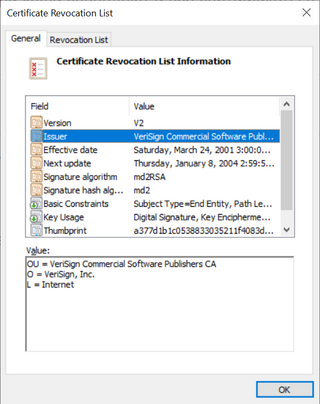
Kerberos is a computer-network authentication protocol that works on the basis of tickets to allow nodes communicating over a non-secure network to prove their identity to one another in a secure manner. Its designers aimed it primarily at a client–server model, and it provides mutual authentication—both the user and the server verify each other's identity. Kerberos protocol messages are protected against eavesdropping and replay attacks.

A public key infrastructure (PKI) is a set of roles, policies, hardware, software and procedures needed to create, manage, distribute, use, store and revoke digital certificates and manage public-key encryption.

In cryptography, a certificate revocation list (CRL) is "a list of digital certificates that have been revoked by the issuing certificate authority (CA) before their scheduled expiration date and should no longer be trusted".
An authentication protocol is a type of computer communications protocol or cryptographic protocol specifically designed for transfer of authentication data between two entities. It allows the receiving entity to authenticate the connecting entity as well as authenticate itself to the connecting entity by declaring the type of information needed for authentication as well as syntax. It is the most important layer of protection needed for secure communication within computer networks.
Integrated Windows Authentication (IWA) is a term associated with Microsoft products that refers to the SPNEGO, Kerberos, and NTLMSSP authentication protocols with respect to SSPI functionality introduced with Microsoft Windows 2000 and included with later Windows NT-based operating systems. The term is used more commonly for the automatically authenticated connections between Microsoft Internet Information Services, Internet Explorer, and other Active Directory aware applications.
Single sign-on (SSO) is an authentication scheme that allows a user to log in with a single ID to any of several related, yet independent, software systems.
NX technology, commonly known as NX or NoMachine, is a remote access and remote control computer software allowing remote desktop access and maintenance of computers. It is developed by the Luxembourg-based company NoMachine S.à r.l. NoMachine is proprietary software and is free-of-charge for non-commercial use.
An authentication server provides a network service that applications use to authenticate the credentials, usually account names and passwords, of their users. When a client submits a valid set of credentials, it receives a cryptographic ticket that it can subsequently use to access various services.
Apple Open Directory is the LDAP directory service model implementation from Apple Inc. A directory service is software which stores and organizes information about a computer network's users and network resources and which allows network administrators to manage users' access to the resources.
In a Windows network, NT LAN Manager (NTLM) is a suite of Microsoft security protocols intended to provide authentication, integrity, and confidentiality to users. NTLM is the successor to the authentication protocol in Microsoft LAN Manager (LANMAN), an older Microsoft product. The NTLM protocol suite is implemented in a Security Support Provider, which combines the LAN Manager authentication protocol, NTLMv1, NTLMv2 and NTLM2 Session protocols in a single package. Whether these protocols are used or can be used on a system, which is governed by Group Policy settings, for which different versions of Windows have different default settings.
Data Protection Application Programming Interface (DPAPI) is a simple cryptographic application programming interface available as a built-in component in Windows 2000 and later versions of Microsoft Windows operating systems. In theory, the Data Protection API can enable symmetric encryption of any kind of data; in practice, its primary use in the Windows operating system is to perform symmetric encryption of asymmetric private keys, using a user or system secret as a significant contribution of entropy. A detailed analysis of DPAPI inner-workings was published in 2011 by Bursztein et al.
Michael Schroeder is an American computer scientist. His areas of research include computer security, distributed systems, and operating systems, and he is perhaps best known as the co-inventor of the Needham–Schroeder protocol. In 2001 he co-founded the Microsoft Research Silicon Valley lab and was the assistant managing director until the lab was disbanded in 2014.
There are a number of security and safety features new to Windows Vista, most of which are not available in any prior Microsoft Windows operating system release.
In some computer security systems, a Ticket Granting Ticket or Ticket to Get Tickets (TGT) is a small, encrypted identification file with a limited validity period. After authentication, this file is granted to a user for data traffic protection by the key distribution center (KDC) subsystem of authentication services such as Kerberos. The TGT file contains the session key, its expiration date, and the user's IP address, which protects the user from man-in-the-middle attacks. The TGT is used to obtain a service ticket from Ticket Granting Service (TGS). User is granted access to network services only after this service ticket is provided.
The Microsoft Open Specification Promise is a promise by Microsoft, published in September 2006, to not assert its patents, in certain conditions, against implementations of a certain list of specifications.
Security Support Provider Interface (SSPI) is a component of Windows API that performs security-related operations such as authentication.
Kerberized Internet Negotiation of Keys (KINK) is a protocol defined in RFC 4430 used to set up an IPsec security association (SA), similar to Internet Key Exchange (IKE), utilizing the Kerberos protocol to allow trusted third parties to handle authentication of peers and management of security policies in a centralized fashion.
A distributed firewall is a security application on a host machine of a network that protects the servers and user machines of its enterprise's networks against unwanted intrusion. A firewall is a system or group of systems that implements a set of security rules to enforce access control between two networks to protect the "inside" network from the "outside" network. They filter all traffic regardless of its origin—the Internet or the internal network. Usually deployed behind the traditional firewall, they provide a second layer of defense. The advantages of the distributed firewall allow security rules (policies) to be defined and pushed out on an enterprise-wide basis, which is necessary for larger enterprises.
Distributed Access Control System (DACS) is a light-weight single sign-on and attribute-based access control system for web servers and server-based software. DACS is primarily used with Apache web servers to provide enhanced access control for web pages, CGI programs and servlets, and other web-based assets, and to federate Apache servers.
SAP Logon Tickets represent user credentials in SAP systems. When enabled, users can access multiple SAP applications and services through SAP GUI and web browsers without further username and password inputs from the user. SAP Logon Tickets can also be a vehicle for enabling single sign-on across SAP boundaries; in some cases, logon tickets can be used to authenticate into 3rd party applications such as Microsoft-based web applications.


